khark
Member
Wonder if there is something that measures somewhat "acceptable" below the JBL305 pricepoint. Interesting subject.
I'm not following your train of thought...Wonder if there is something that measures somewhat "acceptable" below the JBL305 pricepoint. Interesting subject.
I'm not following your train of thought...
We have several well-measuring speakers below US$300/pair (measured by Amir):
- KRK Classic 5
- Kali LP-6
- Fostex PM.03
- Fluid Audio FX50
- Edifier R1280T
Not to mention active speakers that Erin reviewed as well.
I'm not following your train of thought...
We have several well-measuring speakers below US$300/pair (measured by Amir):
- KRK Classic 5
- Kali LP-6
- Fostex PM.03
- Fluid Audio FX50
- Edifier R1280T
Not to mention active speakers that Erin reviewed as well.
Yeah, an on-desk measurement would definitely be interesting here, though things do look rather extreme. I got a pair of these as projector speakers for a colleague, and thought they sounded decent-ish with some tone control adjustments, though the issues in the vertical were definitely noticeable. A single-capacitor crossover no doubt, much like the E4.5 (for which this is much more out of place). Shame 'cause basic dispersion appears to be quite good. A better XO would no doubt help.Wow, that’s a terrible spin. But I do wonder, perhaps the scoop out of the low-mids is intentional to compensate for their intended placement as a computer speaker, sitting directly on a desk below or to the sides of a monitor. The acoustic reflections off the desk from such a placement would boost the low mids quite a lot, but not enough to make it tonally neutral I’d guess. Doesn’t address the bump at 100 Hz either but that’s a popular tuning for these types of product.
Before using an equalizer, it is essential to add a good crossover, I do not know in the Eris E3.5 but in the Eris E4.5 the old model did include a fairly well-made crossver, in the new model it totally loses the crossover by reduction cost and adding one is equal between the difference between day and night, and it shows a lotThe FR is really not good, but can correct. I think this speakers when correct with EQ sound best i have in stereo width. today i open them and want try what happen when i disable the tweeter. I measure this with HF +6 db knob set and no other EQ use. Tweeter cable is cut. maybe i add switches, so i can switch tweeter on and off or choose diffrent capacitor for crossover 10 khz . They are really good wide band speakers too and can to go upto 15 khz - 6 db. when i see avatone mix cube FR or auratone they look not better. there FR spec seem 70-15 khz -10 db. thats worser as eris without tweeter. the big peaks in eris at 1-2 khz stay in. the 8-9 kz can reduce when not exact on axis.
all is 1/3 smoothing 1 is on axis 2 is my hear position i guess 5-10 degree off axis
View attachment 139279
and here can see how the high tech crossover look. this can see when remove the woofer. the right speaker backplate is not removable.
View attachment 139282
the front plate can remove due to pull. need not hard pull
View attachment 139281
the amp is on left speaker and 2 signal cable go to right speaker. the tweeter is only coupled with a capacitor. so 6 db crossover and the woofer have no crossover.
I have done it today in the next time i do tests if wideband speaker really sound better in mid. maybe wide band speaker sound only better in mid when other have slow bass mid woofers that go only upto 5 khz. maybe most larger bass woofers only reach 6 khz but for ITD is more need.
If i find that wide band speakers really sound better, i maybe buy a Omnes Audio BB 3.5. this have good FR upto 18 khz. enough for me. https://www.oaudio.de/out/media/Datasheet_BB3_5.pdf this is in size 3.5 and can replace the eris woofer
Before using an equalizer, it is essential to add a good crossover, I do not know in the Eris E3.5 but in the Eris E4.5 the old model did include a fairly well-made crossver, in the new model it totally loses the crossover by reduction cost and adding one is equal between the difference between day and night, and it shows a lot
The 4.7 capacitor in the tweeter is fine, but adding a true crossover to the woofer turns garbage to gold.
Probably using equalizer without adding a crossover is to equalize the breakage of the woofer cone without further affecting the response of the tweeter.
It is not that the E3.5 and E4.5 models are bad, it is that they have made them bad by reducing costs
Binaural hearing uses two main acoustic cues: interaural time difference (ITD) and interaural level difference (ILD) (Doerbecker and Ernst, 1996; Francart et al., 2011): • ITD is the delay between both ears. It is efficient for low frequencies (below 850 Hz). It is due to the envelope of the signal reaching the two ears. It can be reminded that a sound coming from the side at 90° has an ITD of 0.6 ms. When the source is situated in the front (azimuth 0°), the so-called front target, the ITD is 0 ms. • ILD is related to the intensity reaching the two ears. The signal is more or less attenuated by the head shadow. This effect is mostly perceptible with high frequencies (above 3 kHz). ILD is 0 for the front target.
I have a pair ribbon tweeter monacor RBT 35SR. they can go low to 800 hz when not make loud. I test it with the eris an amp for the rbt 35 sr and the t.racks mini dsp. this dsp have 4 outputs 4 channels 7 eq per channel and each channel have a delay and high and lowpass crossover in many types. delay work in sample steps( 1 step is 1/48 khz) . i notice crossover freq and also 20 microseconds delay between tweeter and woofer change the sound due to FR and phase, but it did not help to give better stereo and room size on eris. only on the kali lp6 with the big 6.5 woofer stereo and width and room reproduction get better when i go lower as the 1,6 khz crossover the default for the lp6. all my tests with ribbon bring me only the result that a ribbon does too not help to get good stereo width as with wide band speakers
I soon get a JBL 104 . this have a 4.5 inch speaker and is coaxial with crossover 1725 hz. this is much lower as the eris (have 2.8 khz). when i compare this with the fullrange eris then i know if it is important to get correct stereo width and room reproducion that only fullrange speaker are good. maybe a coaxial system work too or not. this my tests then show.
here is explain how hear stereo and there is a audio example wav to test if you can hear ITD. it is from simon fraser university.
https://www.sfu.ca/sonic-studio-webdav/handbook/Binaural_Hearing.html
https://www.sciencedirect.com/topics/medicine-and-dentistry/binaural-hearing
a period time of 1 ms is 1 khz frequency. humans are able in tests to hear 0.01- 0.02 miliseconds delay diffrence between speaker. thats less than 1/ 44.1 khz sample
When hear at low volume the level diffrence between left and right ears are very few so this seem another reason that records sound on speakers so much better when hear loud. It is possible for the brain( seem not all people) to create on lower frequency the direction depend on phase. in every music records is a nice sounding room or hall reverb add because it sound better in a concert hall than in bathroom This seem the reason wy wide band speaker on low volumes also give an amazing sound and correct stereo width. when can hear at low volume and get amazing sound and room feeling save ears and the neighbours like more.
Have you continued testing?
I'm sorry. I didn't understand your answer the first time
I understood what you want to achieve in such an absurd way and yes, the speakers in the Eris are quite closed. I was playing with a smartphone, nothing special until I decided to put on a song, the stereo dispersion is so great that I keep wondering how it is that such a small thing can sound so open.
Then. I listened the Presonus Sceptre monitors and there I understood everything
It's one thing for the speakers to have a flat response frequency, and another for stereo dispersion.
But how to achieve both with DIY?
Something, I would like to try the Faital Pro 6HX150 or the Beyma 5CX200Fe, I know they are not hi-fi speakers but, it would be interesting to know if something similar can be achieved, it would not be so farfetched, many current consumer monitors use amplifiers with dsp to equalize the speaker curves
...Erin's and Amir's work creates a yardstick or baseline on what you should expect and what is available at a given price point.
...But I do wonder, perhaps the scoop out of the low-mids is intentional to compensate for their intended placement as a computer speaker, sitting directly on a desk below or to the sides of a monitor. The acoustic reflections off the desk from such a placement would boost the low mids quite a lot, but not enough to make it tonally neutral I’d guess. Doesn’t address the bump at 100 Hz either but that’s a popular tuning for these types of product.
Not being an audio purist (though I dabble in recording and own a Presonus audio interface). I just wanted to appreciate Spotify streaming without the RFI from my cell phone. After searching through all the crap on Amazon, I decided to try the 3.5s because they're powered, small enough to fit behind my monitors (on stands, against the wall and about 60-degrees off-axis) and still cost less than any of the crappy Creative 2.1 desktop systems and knock-offs... very pleased that they reject RFI as that would have been a deal-breaker.
I found this site searching for "Eris 3.5 scoop" because they're boomy and seemed lacking in mids. The write-up and charts were very helpful (if maybe a little TMI for me), but skipping to the Parting / Random Thoughts was perfect. Never would have thought to stuff the ports, but I like these speakers much more now. hardisj, hope my small donation wasn't insulting, but the speakers are only $100.
IMO, Bose ruined consumer audio. Their engineering is impressive, but now bass hype is the single standard for most consumers.
To add my own 2¢review as an actual owner, after reading the thread I don't understand the harsh responses for $100 powered monitors.
These checked all the boxes for computer speakers: cheap, compact with sufficient low-end, self-powered and reject RFI. I would gladly purchase these again (and stuff the ports). No regrets. If this wasn't a company-provided locked-down laptop I would play with some DSP EQ.
I wouldn't mix on them, but I think they're a great playback comparison source and typical of what consumers would hear.
Not being an audio purist (though I dabble in recording and own a Presonus audio interface). I just wanted to appreciate Spotify streaming without the RFI from my cell phone. After searching through all the crap on Amazon, I decided to try the 3.5s because they're powered, small enough to fit behind my monitors (on stands, against the wall and about 60-degrees off-axis) and still cost less than any of the crappy Creative 2.1 desktop systems and knock-offs... very pleased that they reject RFI as that would have been a deal-breaker.
I found this site searching for "Eris 3.5 scoop" because they're boomy and seemed lacking in mids. The write-up and charts were very helpful (if maybe a little TMI for me), but skipping to the Parting / Random Thoughts was perfect. Never would have thought to stuff the ports, but I like these speakers much more now. hardisj, hope my small donation wasn't insulting, but the speakers are only $100.
IMO, Bose ruined consumer audio. Their engineering is impressive, but now bass hype is the single standard for most consumers.
To add my own 2¢review as an actual owner, after reading the thread I don't understand the harsh responses for $100 powered monitors.
These checked all the boxes for computer speakers: cheap, compact with sufficient low-end, self-powered and reject RFI. I would gladly purchase these again (and stuff the ports). No regrets. If this wasn't a company-provided locked-down laptop I would play with some DSP EQ.
I wouldn't mix on them, but I think they're a great playback comparison source and typical of what consumers would hear.
you stuffed the ports? polyfill? how much? LOL. did you stuff them all the way inside to the point where you cant remove the polyfill anymore?
i may have some polyfill somewhere at home.
I have a Temblor T8 Subwoofer addition to eris 3.5s. Should i ignore eq for low freqFull review at my site:
https://www.erinsaudiocorner.com/loudspeakers/presonus_eris_e3_5/
PreSonus Eris E3.5 Powered Monitor Review
- Friday, May 14, 2021
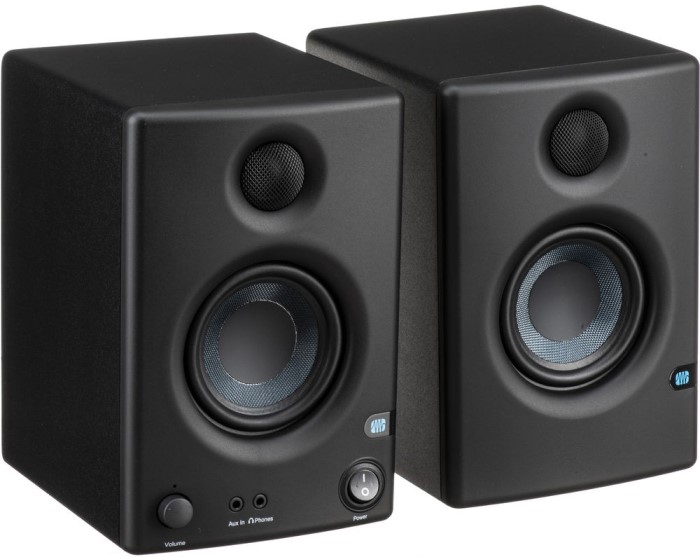
Foreword / YouTube Video Review
The review on this website is a brief overview and summary of the objective performance of this speaker. It is not intended to be a deep dive. Moreso, this is information for those who prefer “just the facts” and prefer to have the data without the filler.
However, for those who want more - a detailed explanation of the objective performance, and my subjective evaluation (what I heard, what I liked, etc.) - please watch the below video where I go more in-depth.
<< coming soon >>
Information and Photos
PreSonus’s Eris E3.5 is a compact powered 2-way speaker featuring a 3-inch mid/woofer and 1-inch dome tweeter. At only $100/pair, they are one of the best-selling “budget” monitor speakers. They feature a stereo 1/8-inch input, Balanced TRS and Unbalanced RCA inputs. The Eris also features both a low-frequency and high-frequency trim to allow you to tailor the sound as needed. The below is from the manufacturer’s website:
PreSonus® Eris-series studio monitors are used worldwide by audio engineers who need to hear every detail of their recordings. Ideal for gaming and home video production, the Eris E3.5 employs the same technology as the larger Eris models to deliver studio-quality sound, with a smooth and accurate frequency response. Yet they’re compact enough to fit almost anywhere.MSRP is about $100 USD for a pair.

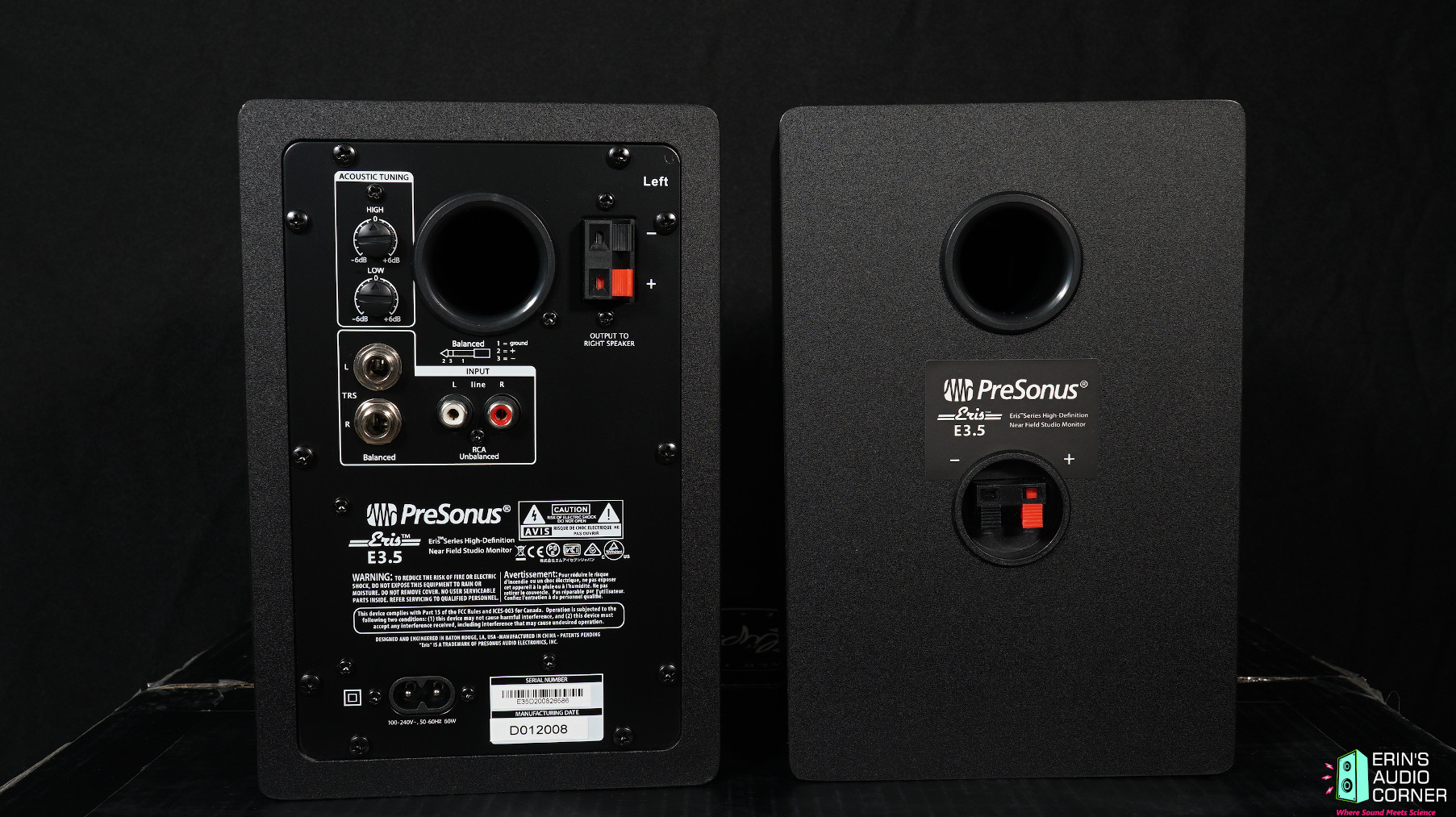
CTA-2034 (SPINORAMA) and Accompanying Data
All data collected using Klippel’s Near-Field Scanner. The Near-Field-Scanner 3D (NFS) offers a fully automated acoustic measurement of direct sound radiated from the source under test. The radiated sound is determined in any desired distance and angle in the 3D space outside the scanning surface. Directivity, sound power, SPL response and many more key figures are obtained for any kind of loudspeaker and audio system in near field applications (e.g. studio monitors, mobile devices) as well as far field applications (e.g. professional audio systems). Utilizing a minimum of measurement points, a comprehensive data set is generated containing the loudspeaker’s high resolution, free field sound radiation in the near and far field. For a detailed explanation of how the NFS works and the science behind it, please watch the below discussion with designer Christian Bellmann:
The reference plane in this test is the tweeter. A single RCA input was used and the volume was set to about 3/4 max. The port was open (not stuffed). All settings were at default (0; no HF or LF adjustments were made).
Measurements are provided in a format in accordance with the Standard Method of Measurement for In-Home Loudspeakers (ANSI/CTA-2034-A R-2020). For more information, please see this link.
CTA-2034 / SPINORAMA:
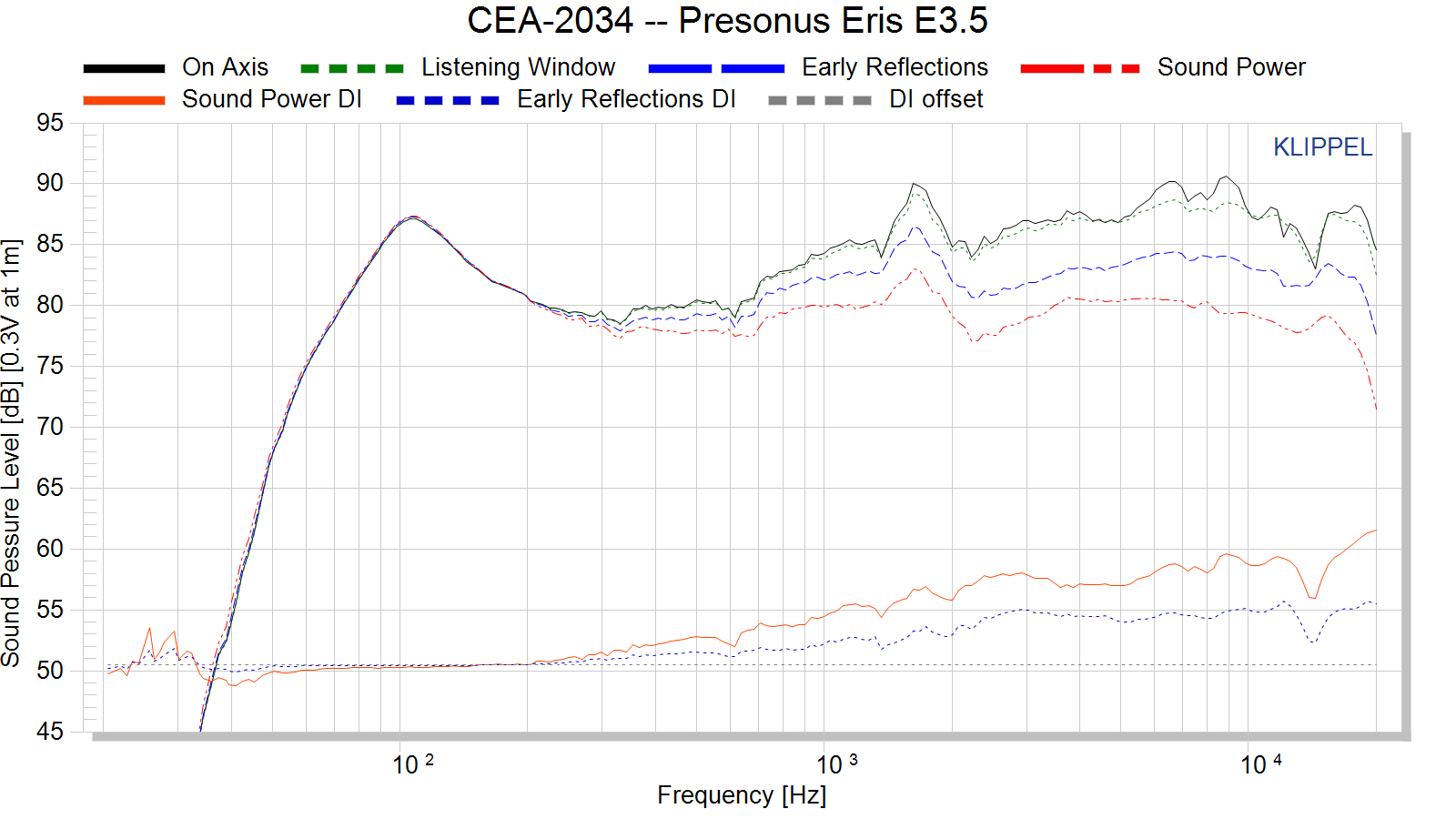
Early Reflections Breakout:

Estimated In-Room Response:

Horizontal Frequency Response (0° to ±90°):

Vertical Frequency Response (0° to ±40°):
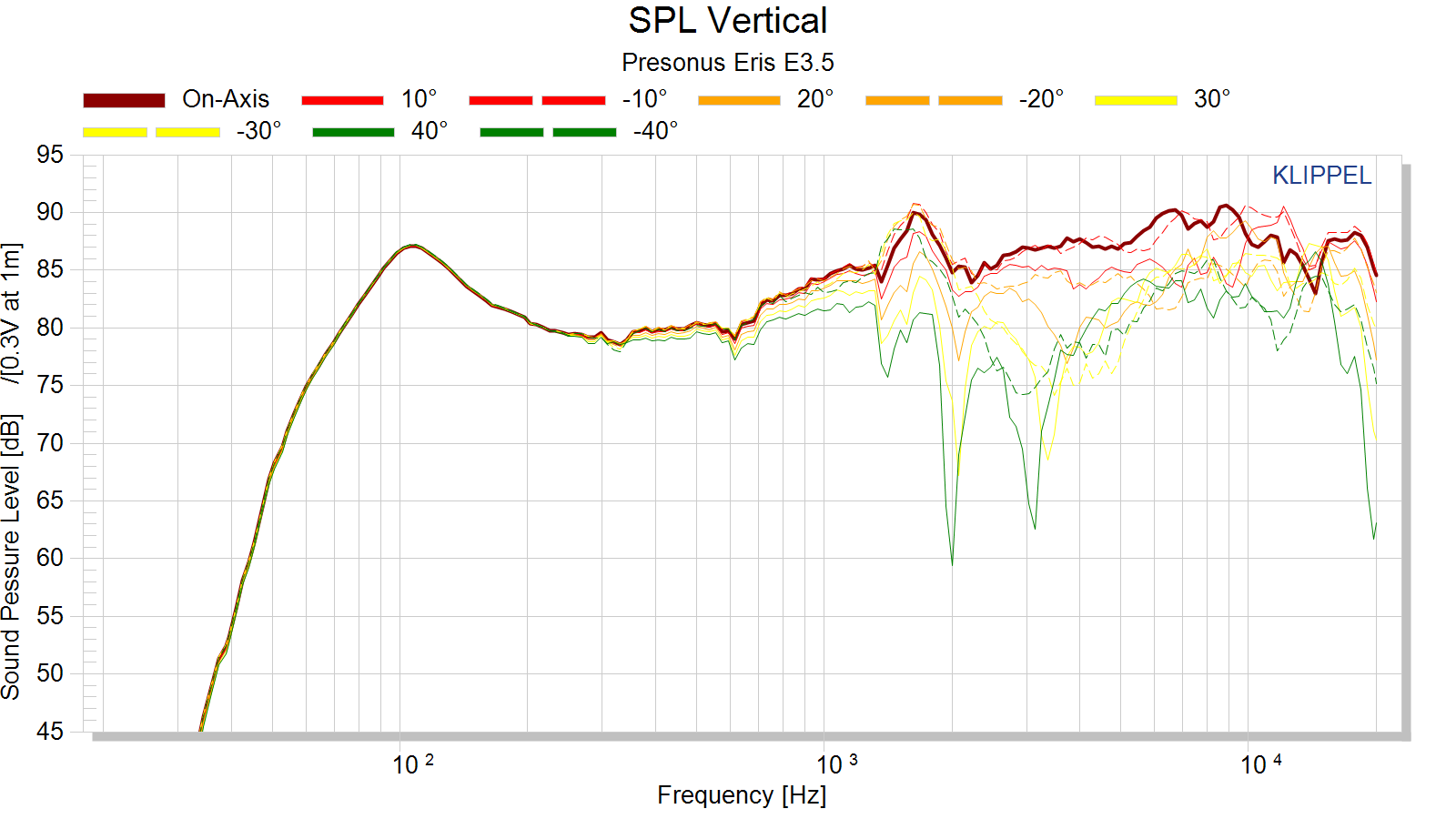
Horizontal Contour Plot (not normalized):
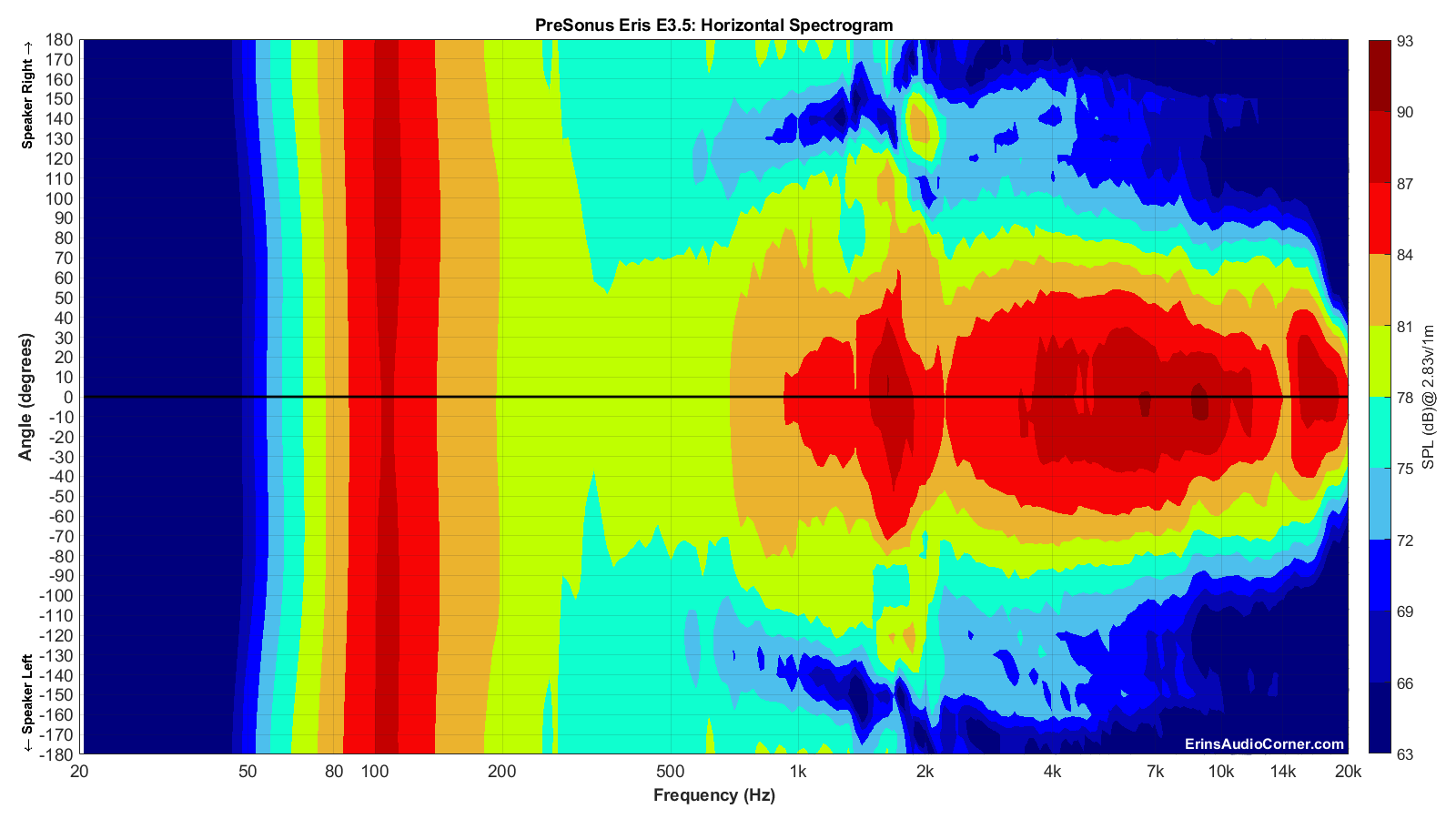
Horizontal Contour Plot (normalized):

Vertical Contour Plot (not normalized):

Vertical Contour Plot (normalized):

Additional Measurements
On-Axis Response Linearity
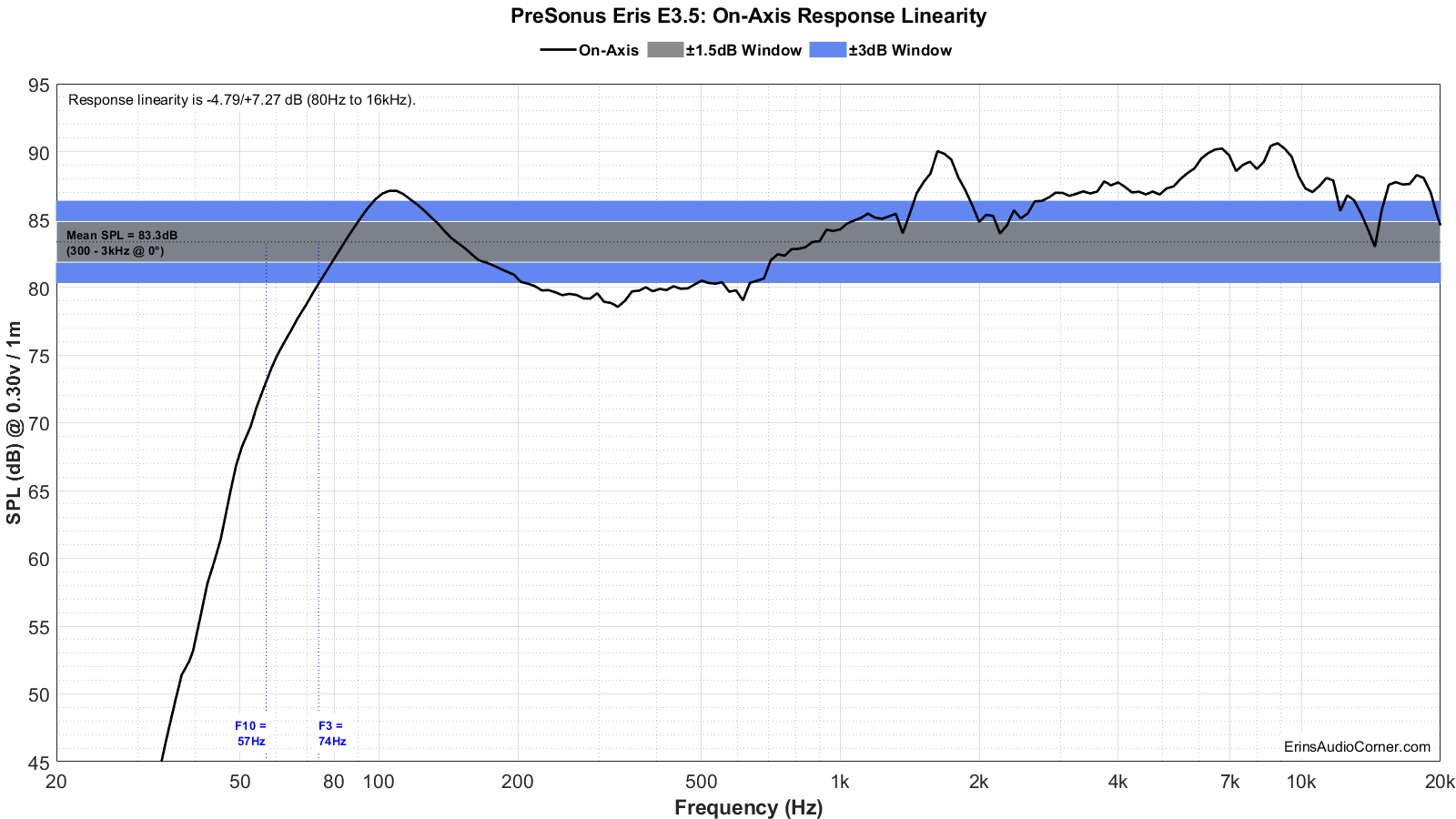
“Globe” Plots
These plots are generated from exporting the Klippel data to text files. I then process that data with my own MATLAB script to provide what you see. These are not part of any software packages and are unique to my tests.
Horizontal Polar (Globe) Plot:
This represents the sound field at 2 meters - above 200Hz - per the legend in the upper left.
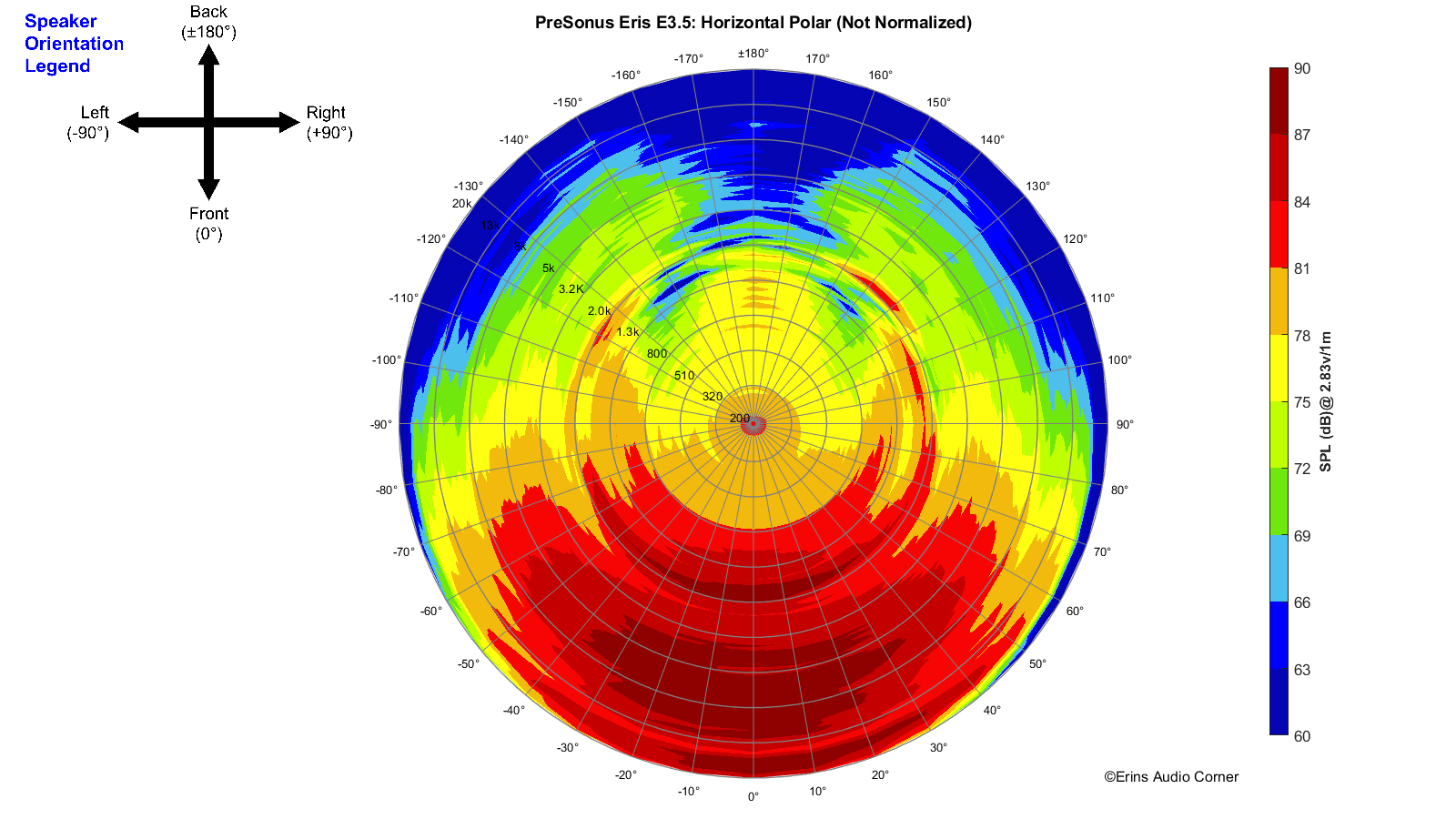
Vertical Polar (Globe) Plot:
This represents the sound field at 2 meters - above 200Hz - per the legend in the upper left.
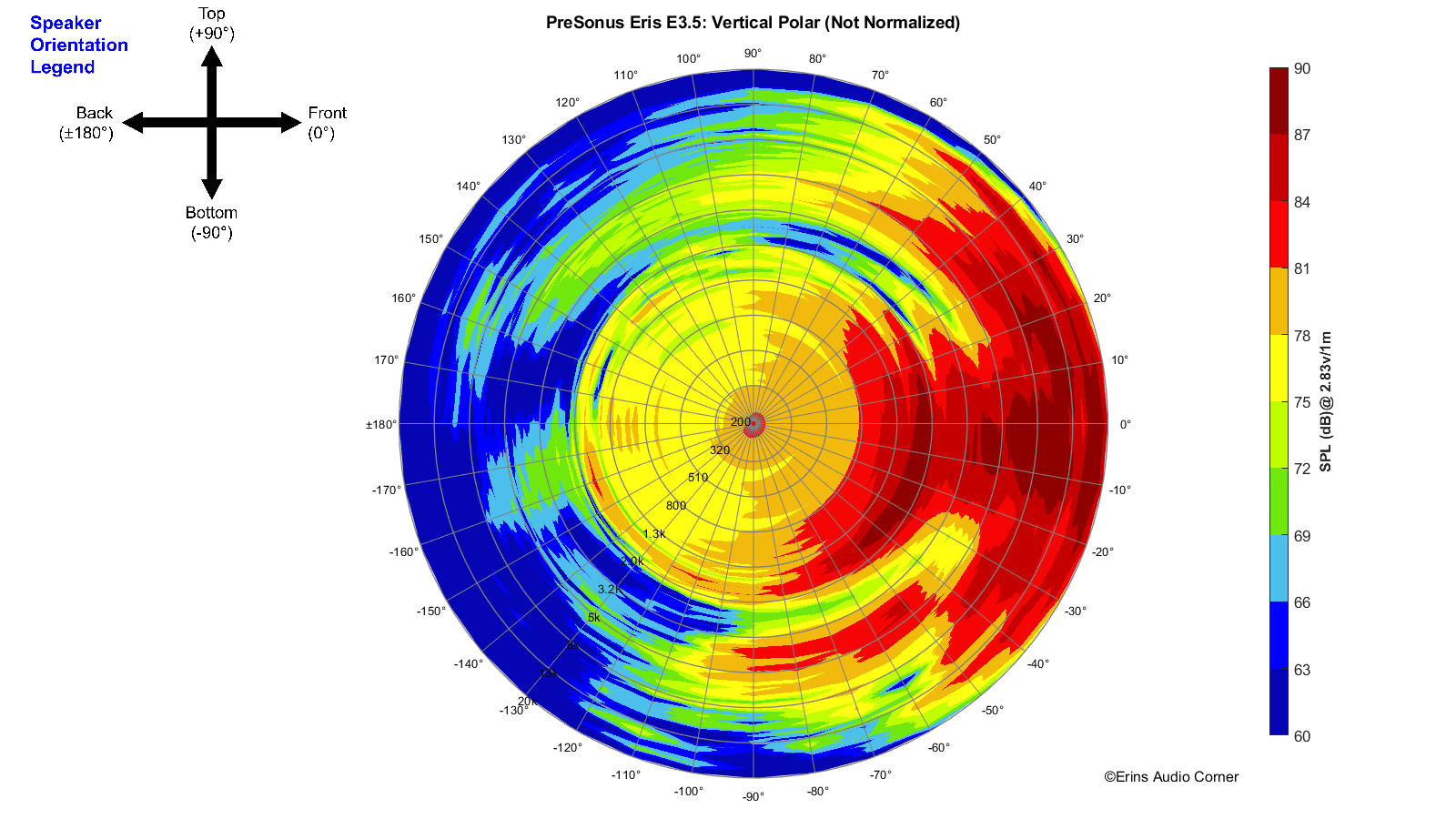
Harmonic Distortion
Harmonic Distortion at 86dB @ 1m:
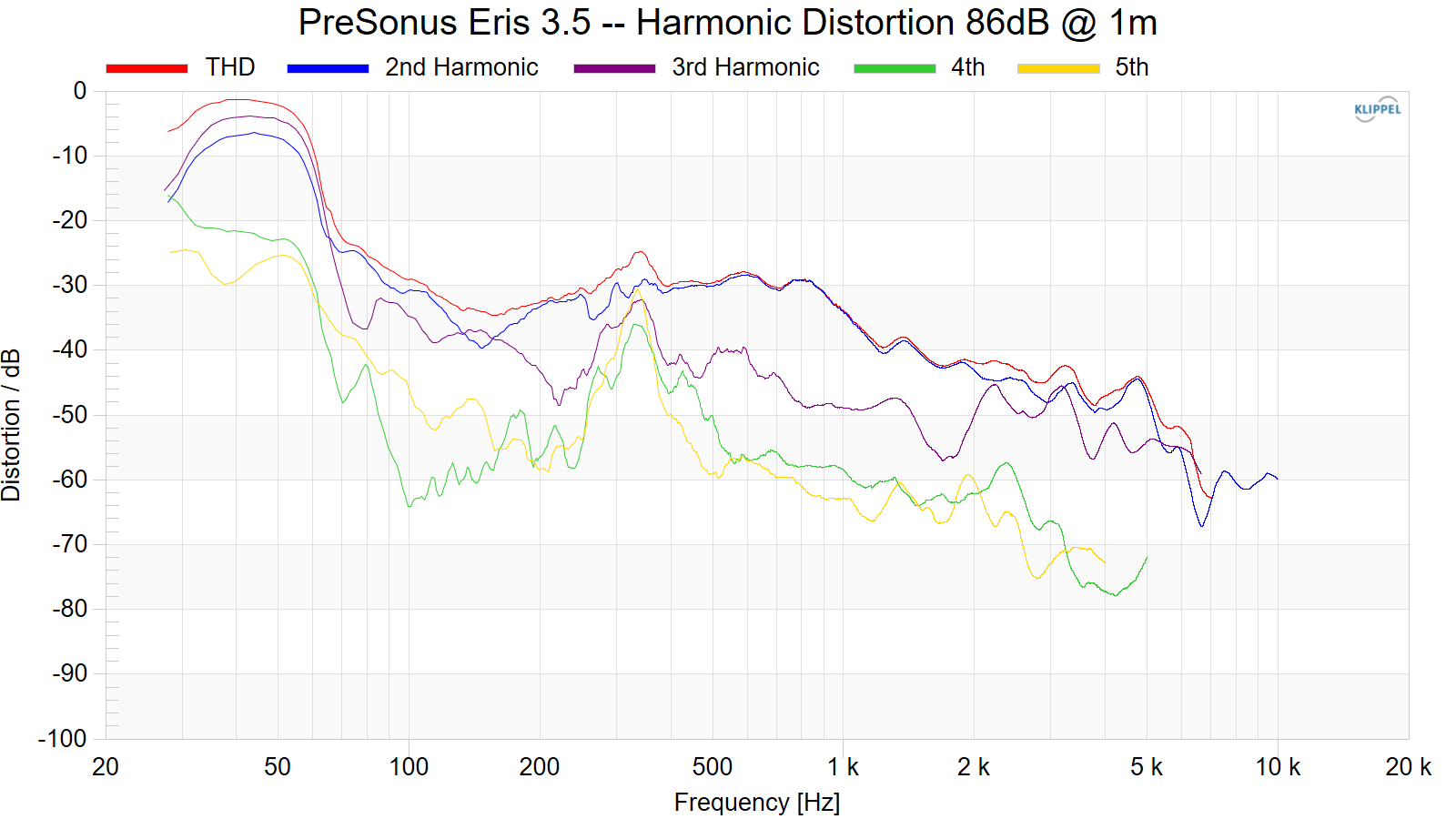
Harmonic Distortion at 96dB @ 1m:
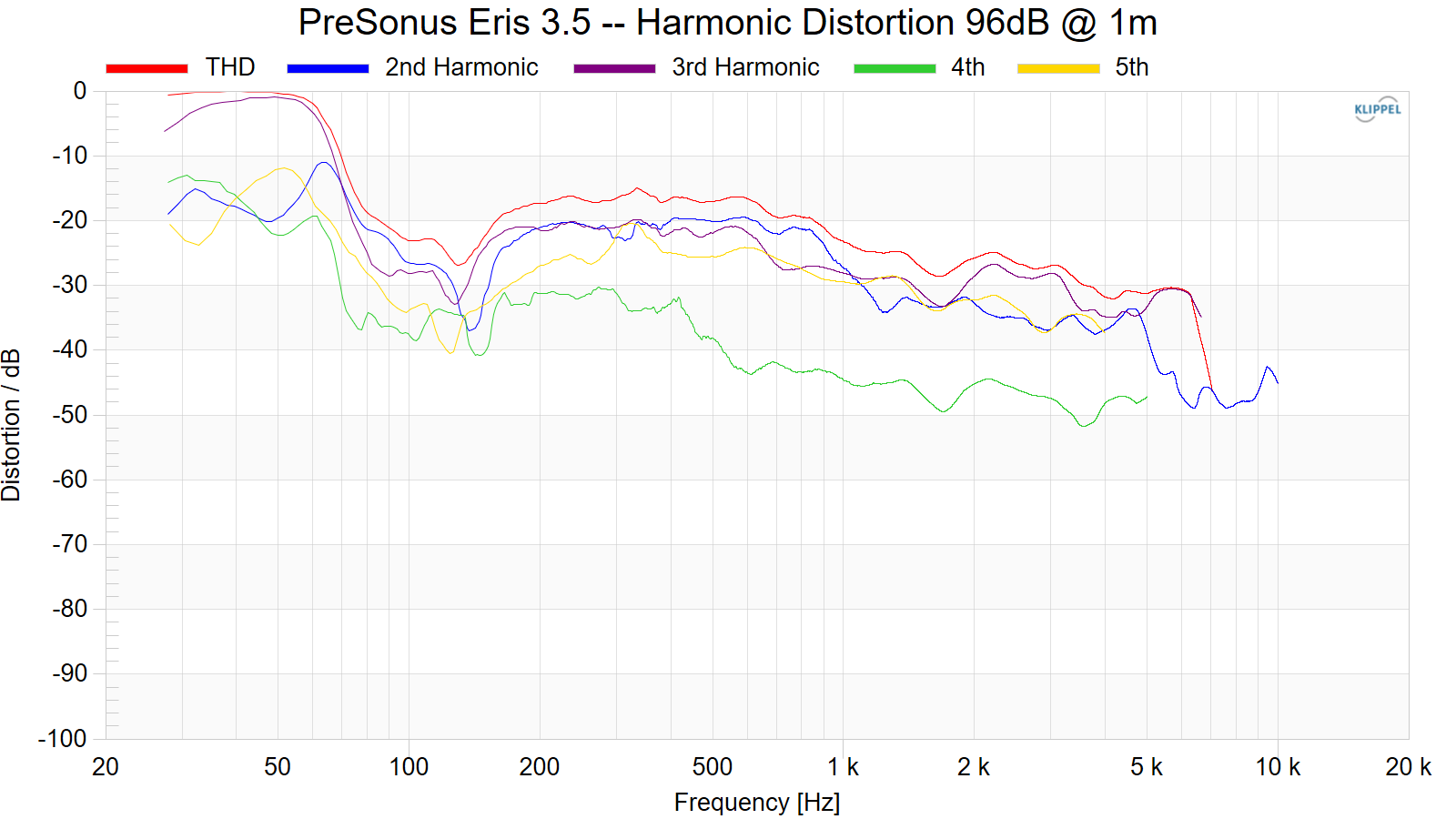
Near-Field Response
Nearfield response of individual drive units:
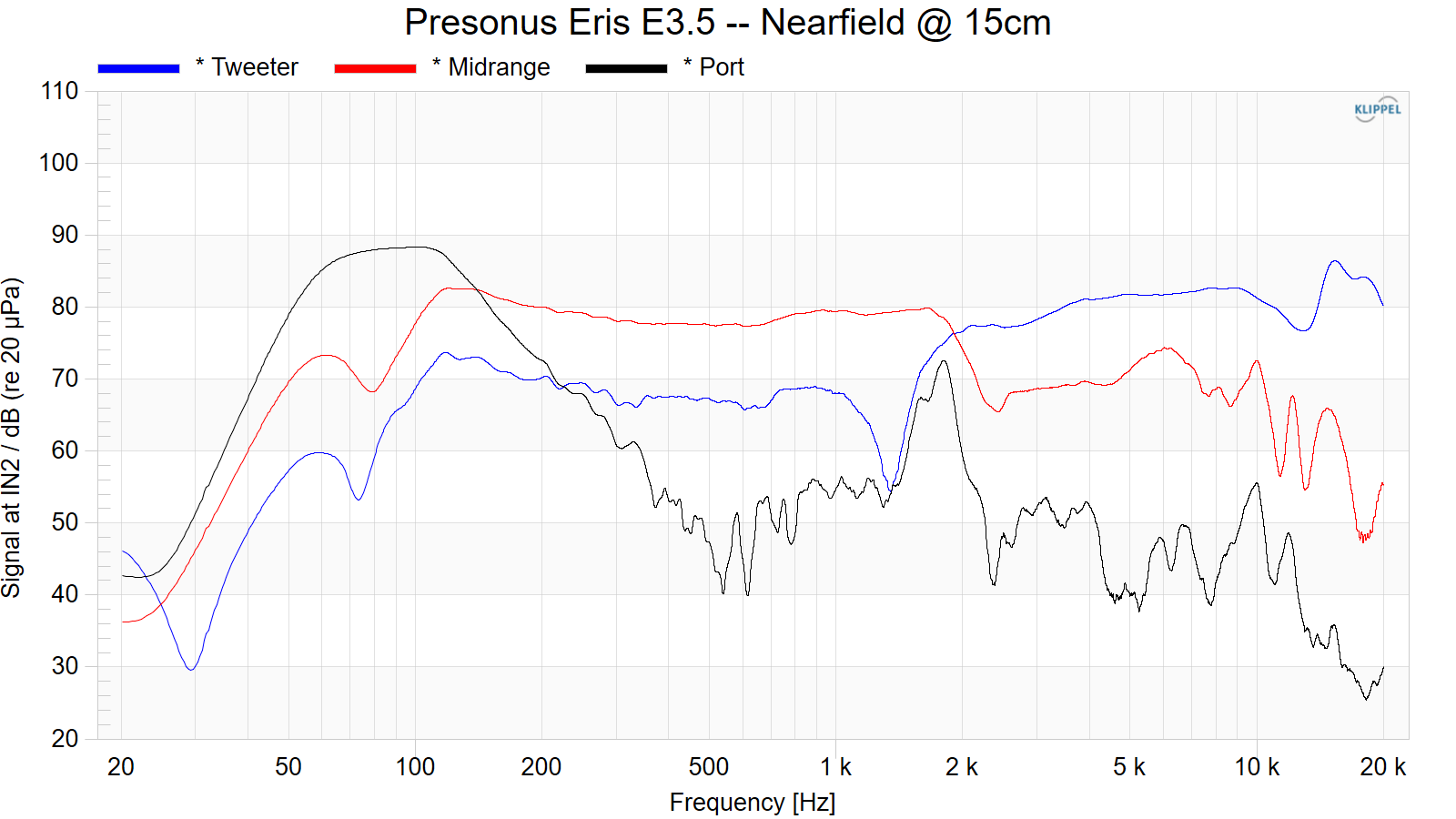
Dynamic Range (Instantaneous Compression Test)
The below graphic indicates just how much SPL is lost (compression) or gained (enhancement; usually due to distortion) when the speaker is played at higher output volumes instantly via a 2.7 second logarithmic sine sweep referenced to 76dB at 1 meter. The signals are played consecutively without any additional stimulus applied. Then normalized against the 76dB result.
The tests are conducted in this fashion:
The purpose of this test is to illustrate how much (if at all) the output changes as a speaker’s components temperature increases (i.e., voice coils, crossover components) instantaneously.
- 76dB at 1 meter (baseline; black)
- 86dB at 1 meter (red)
- 96dB at 1 meter (blue)
- 102dB at 1 meter (purple)

Based on my results above, it is obvious the output is strictly limited. These are not designed to play with a lot of output and instead are best used as computer speakers at moderate volume levels.
Long Term Compression Tests
The below graphics indicate how much SPL is lost or gained in the long-term as a speaker plays at the same output level for 2 minutes, in intervals. Each graphic represents a different SPL: 86dB and 96dB both at 1 meter.
The purpose of this test is to illustrate how much (if at all) the output changes as a speaker’s components temperature increases (i.e., voice coils, crossover components).
The tests are conducted in this fashion:
The red and blue lines represent changes in the output compared to the initial “cold” test.
- “Cold” logarithmic sine sweep (no stimulus applied beforehand)
- Multitone stimulus played at desired SPL/distance for 2 minutes; intended to represent music signal
- Interim logarithmic sine sweep (no stimulus applied beforehand) (Red in graphic)
- Multitone stimulus played at desired SPL/distance for 2 minutes; intended to represent music signal
- Final logarithmic sine sweep (no stimulus applied beforehand) (Blue in graphic)
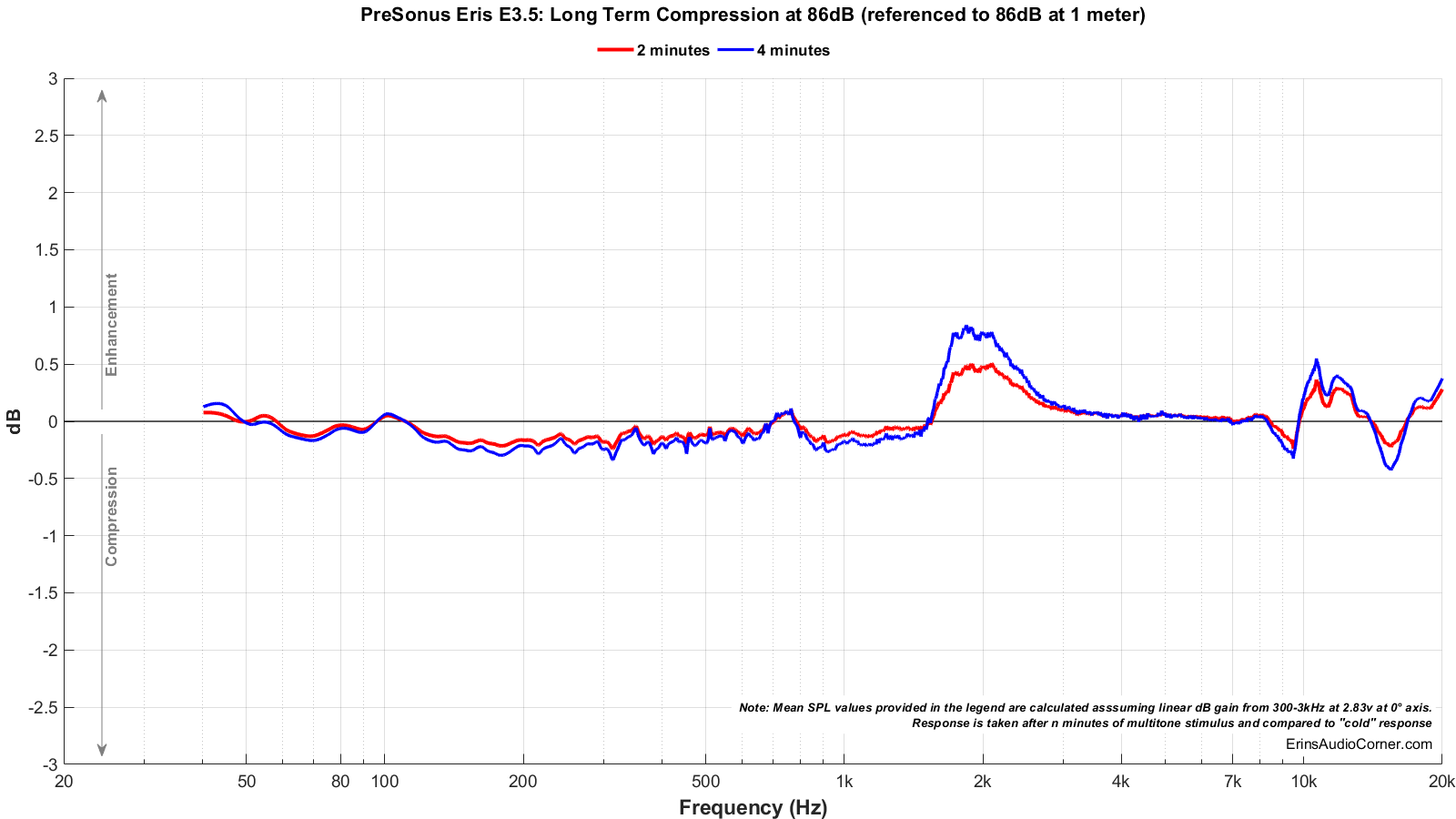
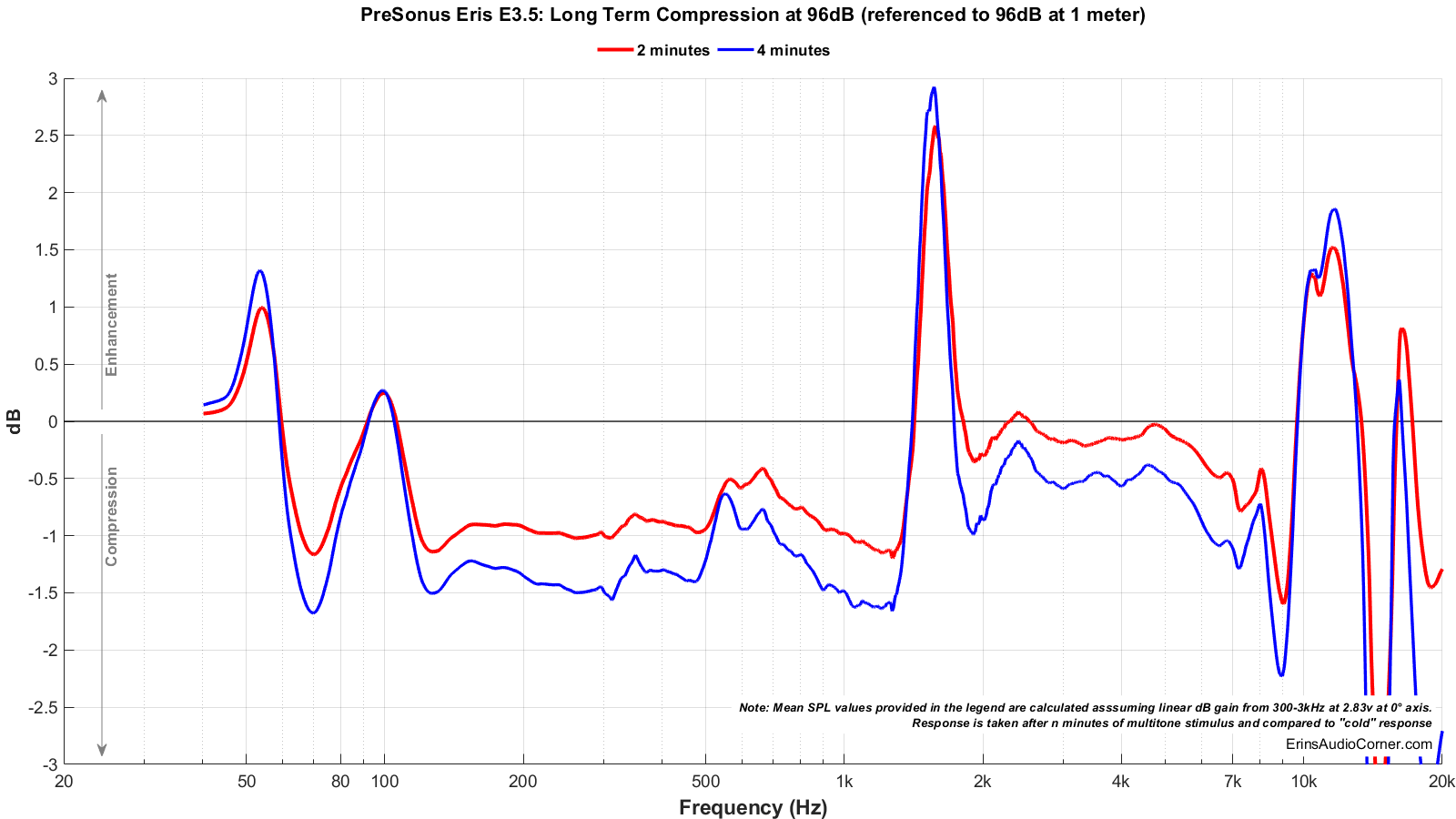
Parting / Random Thoughts
If you want to see the music I use for evaluating speakers subjectively, see my Spotify playlist.
As is, with no tonal adjustments made via the knobs on the back of the speaker, you have an extreme “smiley face” or “v-curve” response with a peaky midbass around 100Hz and a very bright sounding treble. The midrange is very recessed and the enclosure is the source of strong resonances. Certainly not something I would consider useful in mixing or monitoring as the ideal response for those situations should obviously be an uncolored, neutral (flat) speaker response on-axis.
- Subjective listening varied between 0.50 to 2 meters. Subjective listening was conducted at 80-95dB at these distances. Higher volumes were done simply to test the output capability in case one wants to try to sit further away.
After fiddling with the settings, listening and running the NFS tests a few more times, I ultimately found this setup offers the best compromise:
While still not ideal, this gives a more linear response without significant peaking in the midbass and overaccentuated highs. Doing so yields the following SPIN results:
- Stuff the ports. Yes, I know you want the speakers to get lower but the ports only serve to mess up the response. You can use a shirt, small dish towel… whatever plugs up the port.
- Set the HF to “-6dB”.
- Set the LF to “+3dB”.

You may be trying to choose between these speakers and the Mackie CRX-3 I have also reviewed. They each have their own issues. My suggestion as to which to buy boils down to this:
You can view a comparison of the on-axis response between the two speakers below.
- No matter what speaker you buy STUFF THE PORT. It doesn’t help you get any lower. In fact, it only serves to provide a resonant bump ~ 100Hz and results in a steeper roll off.
- If you don’t plan to adjust tonal balance knobs on the PreSonus then get the Mackie. Easy choice.
- I think it is a coin toss between the Mackie CR3-X and the adjusted PreSonus E3.5. Though, I’d probably leave toward the Mackie as it still has a more neutral response (especially with the port stuffed).
- If you are placing these near a wall the PreSonus’ tonal controls may prove useful enough (by lowering the boosted bass as you put the speaker near a wall) and make the decision to go that route easier. Though, I would recommend turning the speakers off axis; otherwise the treble is too much. 30° to 40° looks to be the best compromise. Still, the Mackie’s HF balance appears better when the same positioning is used for that speaker.
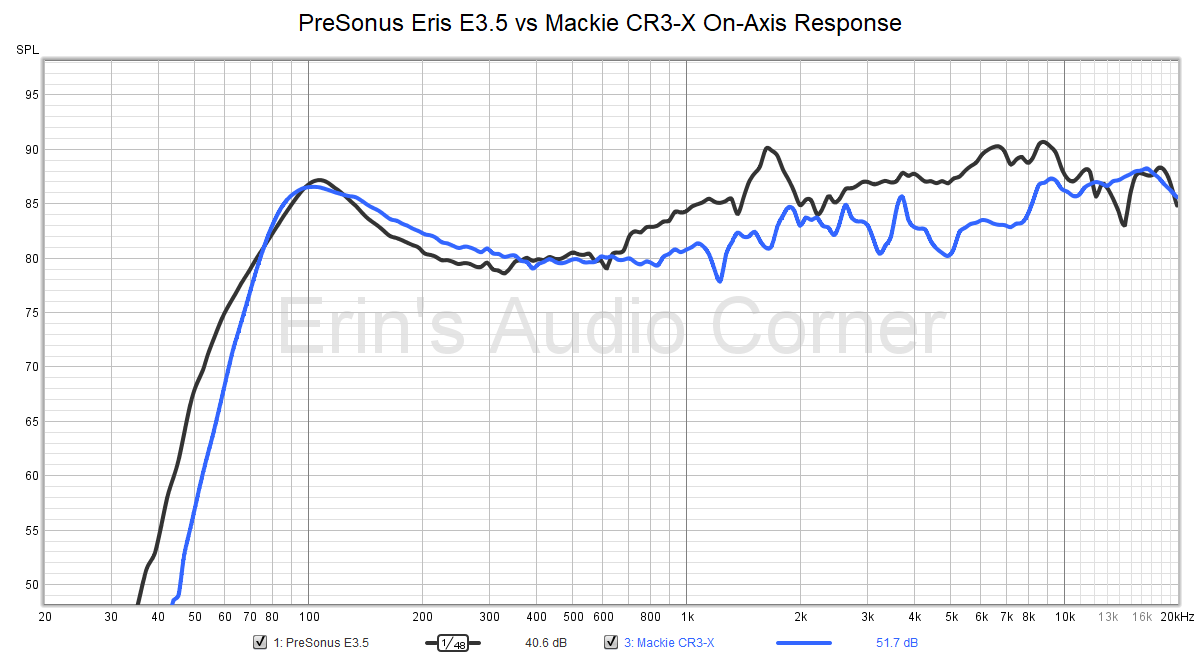
However, if you adjust the Eris E3.5’s tonal balance controls and port stuffing as I had recommended then this is the comparison:
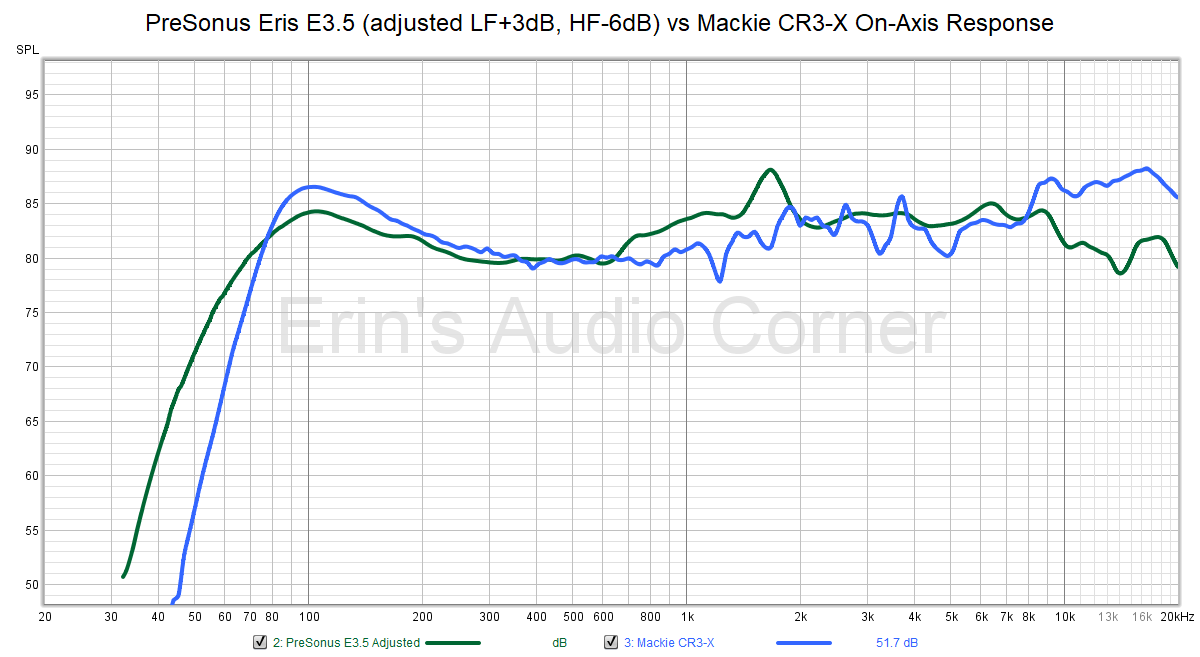
As with anything else, I suggest purchasing these from a retailer who offers a return policy so you can try these out in-home. If you’re in search of such a retailer, please consider using my B&H affiliate link below.
As stated in the Foreword, this written review is purposely a cliff’s notes version. For more details about the performance (objectively and subjectively) please watch the YouTube video.
DSP Suggestions
If you have the means, I recommend using EQ to help flatten out the response and achieve a more neutral response, as a set of monitor speakers should provide. Doing so will help immensely and is necessary in my humble opinion. I have provided two examples created via REW software’s auto-EQ program based on a standard miniDSP. They are provided in a screenshot below. If you need help understanding how to use these, I encourage you to check out NoAudiophile’s page here which also has other DSP suggestions for various speakers. It is a great resource for this type of thing.
You’ll probably have to increase the photo size to see the individual settings.
- DSP Suggestion for the “out of the box” response:
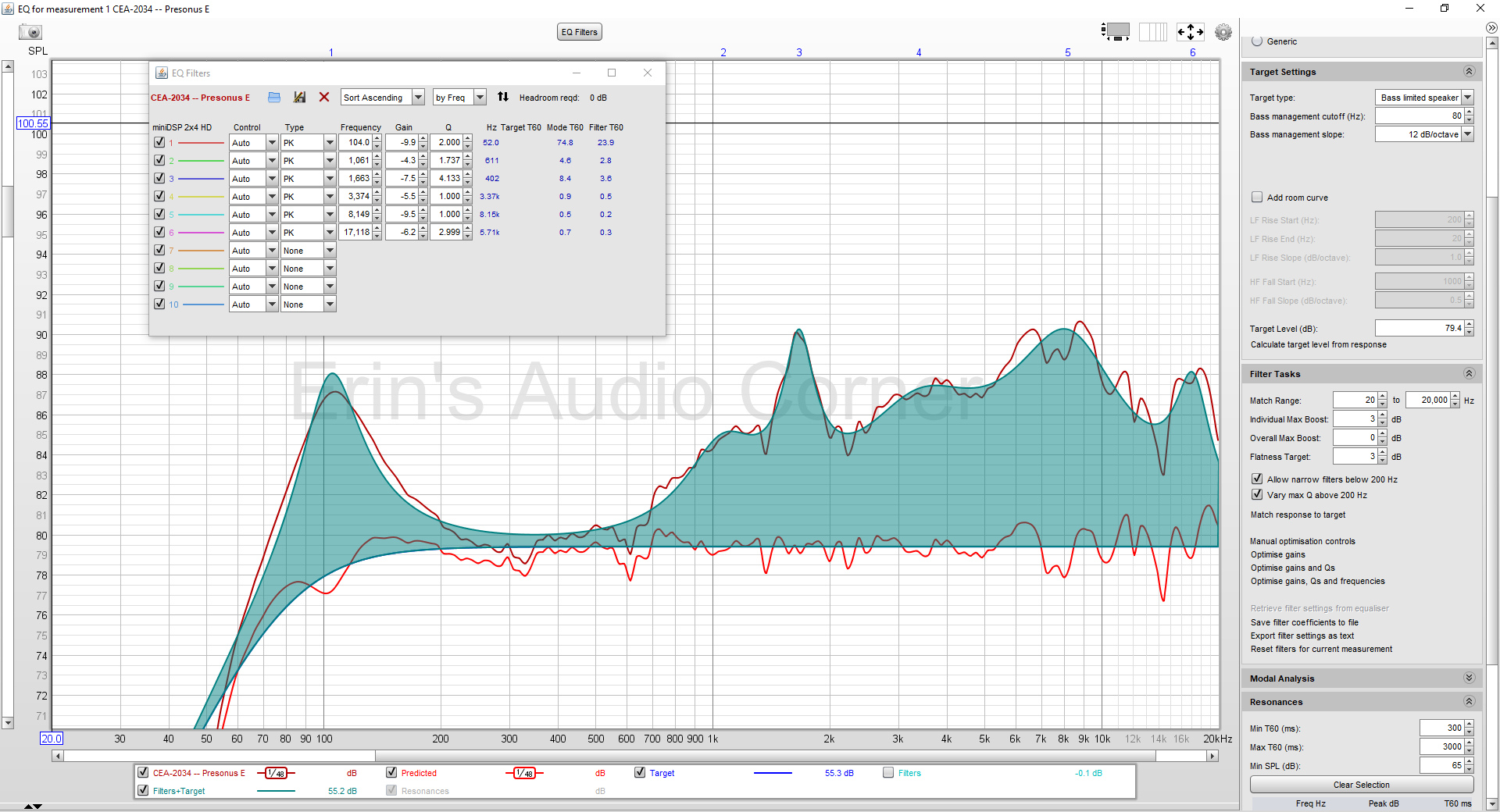
- DSP Suggestion using my recommended settings (port stuffed, HF/LF trim enabled for -6dB/+3dB, respectively):
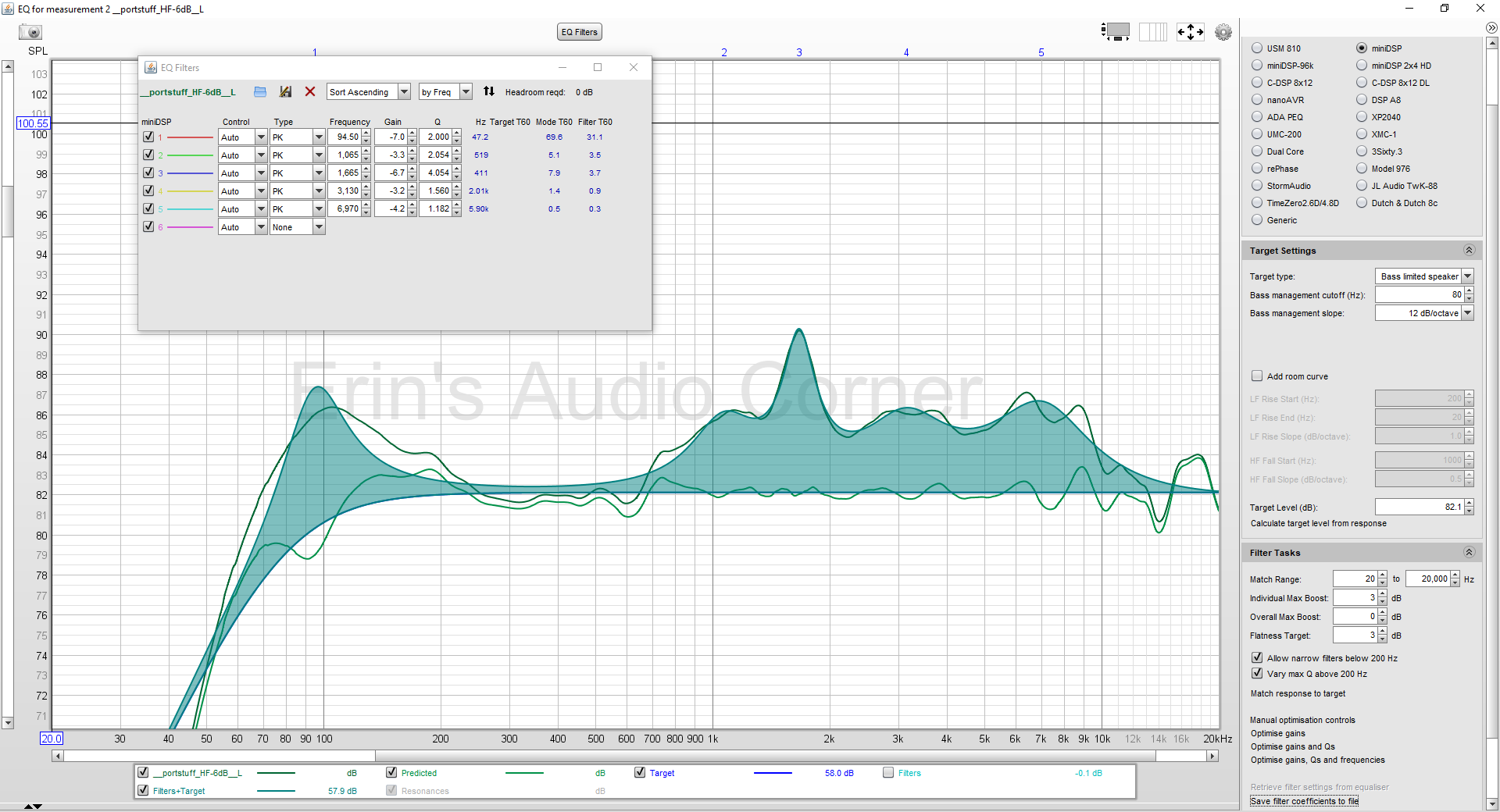
Support / Contribute
If you like what you see here and want to help me keep it going, please consider donating via PayPal here. Donations help me pay for new items to test, hardware, miscellaneous items and costs of the site’s server space and bandwidth. All of which I otherwise pay out of pocket. So, if you can help chip in a few bucks, know that it is very much appreciated. Alternatively, if you are interested in purchasing these speakers, please consider using my B&H affiliate link found on my site. It yields me a small commission at no additional cost to you and allows me to keep doing what I am doing.
You can also join my Facebook and YouTube pages if you would like to follow along with updates.
